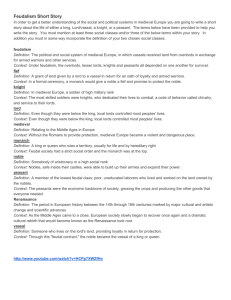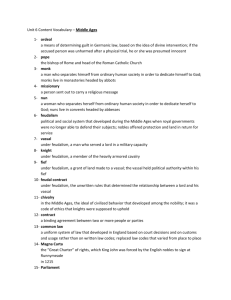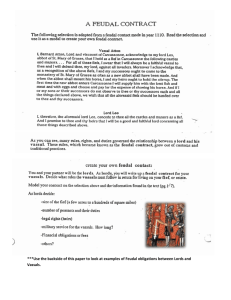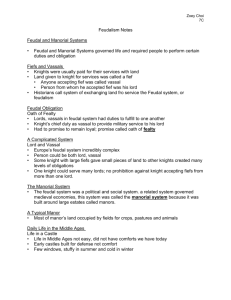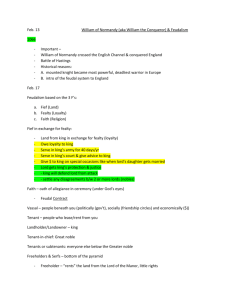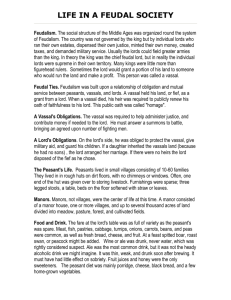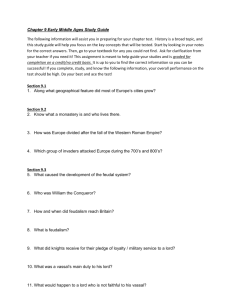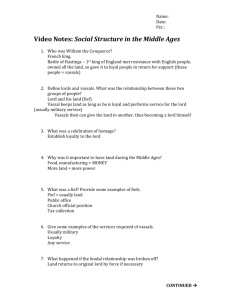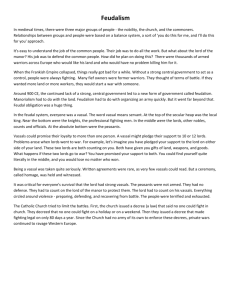Database Source
advertisement
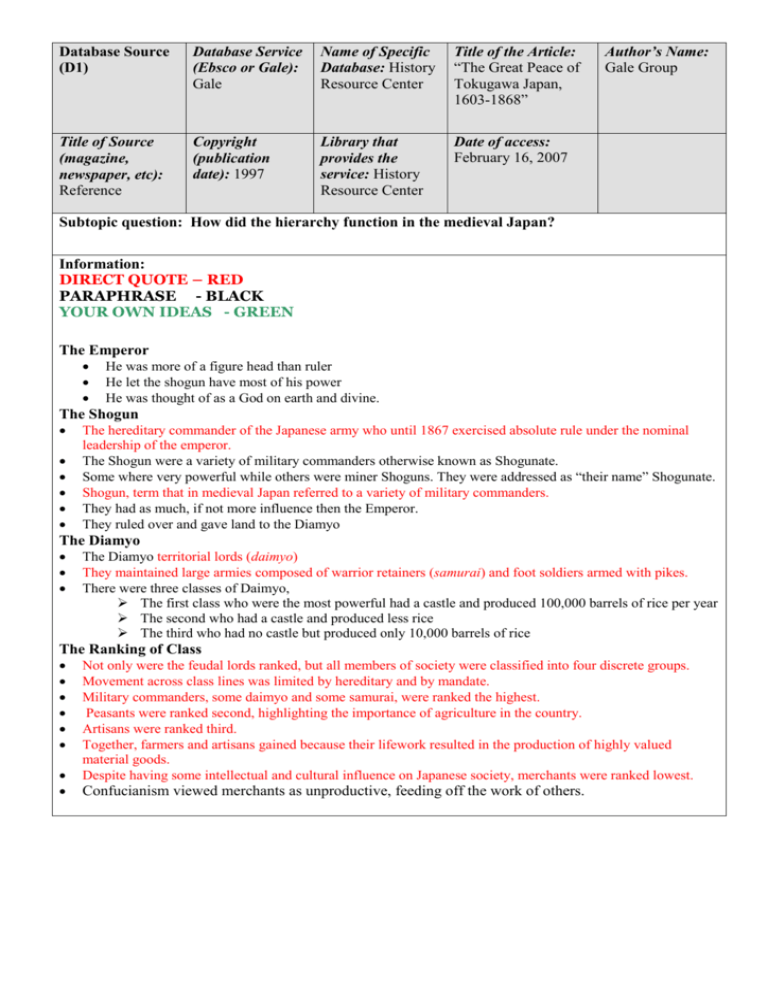
Database Source (D1) Database Service (Ebsco or Gale): Gale Name of Specific Database: History Resource Center Title of the Article: “The Great Peace of Tokugawa Japan, 1603-1868” Title of Source (magazine, newspaper, etc): Reference Copyright (publication date): 1997 Library that provides the service: History Resource Center Date of access: February 16, 2007 Author’s Name: Gale Group Subtopic question: How did the hierarchy function in the medieval Japan? Information: DIRECT QUOTE – RED PARAPHRASE - BLACK YOUR OWN IDEAS - GREEN The Emperor He was more of a figure head than ruler He let the shogun have most of his power He was thought of as a God on earth and divine. The Shogun The hereditary commander of the Japanese army who until 1867 exercised absolute rule under the nominal leadership of the emperor. The Shogun were a variety of military commanders otherwise known as Shogunate. Some where very powerful while others were miner Shoguns. They were addressed as “their name” Shogunate. Shogun, term that in medieval Japan referred to a variety of military commanders. They had as much, if not more influence then the Emperor. They ruled over and gave land to the Diamyo The Diamyo The Diamyo territorial lords (daimyo) They maintained large armies composed of warrior retainers (samurai) and foot soldiers armed with pikes. There were three classes of Daimyo, The first class who were the most powerful had a castle and produced 100,000 barrels of rice per year The second who had a castle and produced less rice The third who had no castle but produced only 10,000 barrels of rice The Ranking of Class Not only were the feudal lords ranked, but all members of society were classified into four discrete groups. Movement across class lines was limited by hereditary and by mandate. Military commanders, some daimyo and some samurai, were ranked the highest. Peasants were ranked second, highlighting the importance of agriculture in the country. Artisans were ranked third. Together, farmers and artisans gained because their lifework resulted in the production of highly valued material goods. Despite having some intellectual and cultural influence on Japanese society, merchants were ranked lowest. Confucianism viewed merchants as unproductive, feeding off the work of others. Web Source (I1) Author: Wikipedia Foundation Date of Publication (check copyright date, last updated or date of publication): February 15, 2007 Web Address Date of access: February 17, 2007 (www...): <http://en.wikipedia .org/wiki/History_o f_Japan#Feudal_Ja pan>. Title of Web Page (article in the page): History of Japan Title of Web Site: Wikipedia Publisher (check copyright): Wikipedia Foundation Subtopic question: How did the hierarchy function in the medieval Japan? Information: DIRECT QUOTE – RED PARAPHRASE - BLACK YOUR OWN IDEAS - GREEN The Emperor The Emperor remained but was (mostly) kept to a de jure figurehead ruling position. He let the shoguns have most, if not all of the power However, to keep his reputation in tact he led the people to believe that he still had supreme rule. Lord A lord was otherwise a shogun, who could grant land to the daimyo. Before a lord could give a fief (land) to someone, he had to make him a vassal. This was done at a formal symbolic ceremony called a commendation ceremony. It consisted of a two-part act of homage and oath of fealty. The lord’s principal obligation was to grant a fief, or its revenues to the vassal. The fief is the primary reason that the vassal chose to enter into the relationship. However, the lord also has to fulfill other obligations to his vassal and fief. Those obligations consisted of: The maintenance of the fief, as the lord had only lent the fief it is his job to care for it. The lord also has to protect the vassal from harm Vassal At the commendation ceremony, a vassal must swear his homage and fealty to the lord before he could attain the fief. Homage: the vassal would promise to fight for the lord at his command. Fealty: the vassal would promise to be faithful to the lord. The vassal’s principal obligation was to provide aid, or military service, he did this by using equipment the vassal could obtain by virtue of the revenues from the fief, the vassal was responsible to answer to calls to military service on behalf of the lord. This was the primary reason the lord entered the relationship, in addition the vassal had to also fulfill other orders to the lord. Such obligations consisted of: Providing the lord with counsel so that if the lord faced a major decision he would summon all his vassals for a counsel. Providing a certain amount of his farms yield to support his lord. Also to grind his wheat and bake bread in the mills and ovens owned and taxed by the lord. Fief The relationship between the lord and vassal revolved around the fief. Depending on the power of the granting lord, fiefs could range in size from a small farm to a much larger area of land. Web Source (I2) Author: Andersen, Petter Løken Date of Publication (check copyright date, last updated or date of publication): May 31, 2001 Web Address (www...): Date of access: <http://home.online.no/ February 17, 2007 ~p-loeand/samurai/histeng.htm>. Title of Web Page (article in the page): Honor Title of Web Site: History of Samurai Publisher (check copyright): Subtopic question: How did the hierarchy function in the medieval Japan? Information: DIRECT QUOTE – RED PARAPHRASE - BLACK YOUR OWN IDEAS - GREEN Samurai After the original Samurai gained their status and prospered their children inherited the power, they no onger had to really work to achieve it. However, they still had to be disciplined and follow the bushido to be considered honorable. Web Source (I3) Author: Title of Web Page (article in the page): Vassal Date of Publication (check copyright date, last updated or date of publication): Date of access: Web Address February 18, 2007 (www...): <http://concise.brita nnica.com/ebc/artic le-9074888/vassal> Title of Web Site: Encyclopedia Britannica Publisher (check copyright): Britannica Concise Encyclopedia Subtopic question: How did the hierarchy function in the medieval Japan? Information: DIRECT QUOTE – RED PARAPHRASE - BLACK YOUR OWN IDEAS - GREEN Feudal Society In general feudal society, a vassal invested with a fief for services to a lord. Under the feudal contract, the lord had the duty to provide a fief for his vassal, to protect him and to do him justly in court. In return the lord had a right to demand the services attached to the fief (military, judicial, administrative) and had a right to various incomes known as feudal incomes. Relief, a tax paid when a fief was transferred to a heir or alienated by the vassal. Scutage, a tax paid in lieu of military service. The vassal also owned fealty to his lord. When a vassal dies its fief goes directly to his older son, who is bound to the lord as well However, if a vassal dies without heir or has committed a crime or felony, his fief goes directly back to the lord.
